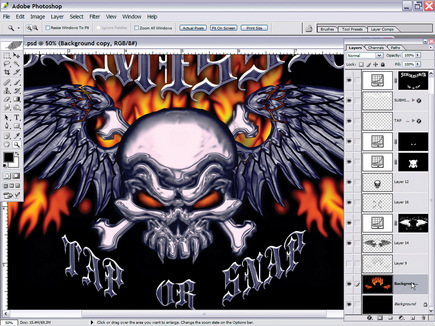In 1913, a photograph was taken at a San Francisco company that showed advertising posters being printed through stencils on silk mesh that had been stretched across a wooden frame. We know that process as screen printing, and the photo (taken at the Velvetone Poster Company) is the first recorded evidence of its use. It was an innovation, one that would spread around the world by the early 1930s.
In 1913, a photograph was taken at a San Francisco company that showed advertising posters being printed through stencils on silk mesh that had been stretched across a wooden frame. We know that process as screen printing, and the photo (taken at the Velvetone Poster Company) is the first recorded evidence of its use. It was an innovation, one that would spread around the world by the early 1930s.
Screen Printing traditionally concludes each year with a special edition, and for this installment, we’re focusing on innovation. It seemed a highly appropriate theme for a process that has played a role in so many other developments. You can make a case that over the past century, screen printing has factored into most of the seismic technological and lifestyle shifts that have taken place.
Yet, those true, transformative breakthroughs – things like printed circuits, solar cells, and smartphones – are quite rare. Most of us strive to “innovate or die” (borrowing the title of Jack Matson’s 1981 book), but in reality, we spend much more of our professional lives trying to sort out what to do about things that have been invented by others. Mark Coudray leads off our special section by explaining how the process of innovation works, and what it means for business owners as they wrestle with whether they should adopt a new technology, and if so, when. It’s a must-read at a time when the stakes of our technology decisions have perhaps never been higher.
Next, we look at how three innovations that are highly relevant in specialty printing today came to be. These unlikely ideas – one from an artist who was a newcomer to the industry, the others from vendors who were venturing outside their usual fields – underscore other realities about innovation. It’s unexpected. It’s messy. It demands quixotic fidelity to a vision others can’t comprehend, often for decades. And no matter how transformative the idea, it almost always builds upon progress that was made before.
Advertisement
Certainly, that’s true of screen printing. Though they were unquestionably pioneers in commercializing the process, Velvetone almost certainly wasn’t the first to use it, as Guido Lengwiler chronicled in his excellent book, “A History of Screen Printing.” Earlier felt pennants show signs of having been screen printed. Mimeographs and other stencil replicators from the 19th century were clearly inspirations, as were Japanese stencil prints that went back much further. A 1902 French patent even anticipated a six-station rotary textile press, complete with an open station for loading and unloading.
That’s specialty printing, in a nutshell: Borne of invention, with each new innovation illuminating the pathway to the next, and the process repeating indefinitely. It’s a history we’re proud to have shared.
P.S. As we prepared this issue, I reached out to my colleagues in the Academy of Screen and Digital Printing Technologies for their suggestions. Underscoring how much innovation this industry can celebrate, they offered more ideas that we could squeeze into the issue. One in particular, an essay from Mike Ruff on prepress innovation, deserves your attention. Be sure to read it at screenweb.com/innovation-prepress.
Read more from The Innovation Issue.


 Case Studies2 months ago
Case Studies2 months ago
 Art, Ad, or Alchemy2 months ago
Art, Ad, or Alchemy2 months ago
 Andy MacDougall2 months ago
Andy MacDougall2 months ago
 Columns3 weeks ago
Columns3 weeks ago
 Editor's Note3 weeks ago
Editor's Note3 weeks ago
 Marshall Atkinson3 weeks ago
Marshall Atkinson3 weeks ago
 Thomas Trimingham2 months ago
Thomas Trimingham2 months ago
 News & Trends2 months ago
News & Trends2 months ago
















